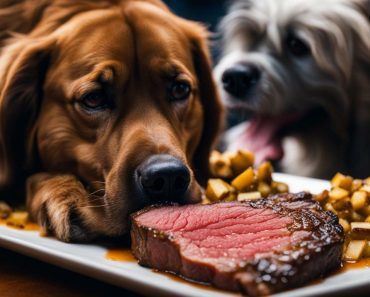Hello, I’m here to share some valuable tips and insights on managing dog eye issues. As pet owners, we want our furry friends to have healthy and bright eyes. However, it’s not uncommon for dogs to experience eye problems that can cause discomfort and affect their overall well-being.
Dog eye issues encompass a range of conditions, including infections, diseases, discharge, irritation, allergies, redness, and dryness. Identifying these problems early and providing the right care is essential to ensure your dog’s eye health.
Key Takeaways:
- Common dog eye problems can include infections, diseases, discharge, irritation, allergies, redness, and dryness.
- Regular veterinary check-ups are crucial for early detection of eye issues and appropriate treatment.
- Administering eye drops or ointments as prescribed by your veterinarian can effectively manage many dog eye problems.
- Seek veterinary care for persistent or severe eye problems to prevent potential complications.
- Take preventive measures like regular grooming and protecting your dog’s eyes during certain activities.
Common Eye Conditions and Symptoms in Dogs
As dog owners, it’s essential to be familiar with the common eye conditions that can affect our furry friends. Dogs can experience various eye problems, including dry eye, conjunctivitis, corneal ulceration, epiphora, cataracts, and glaucoma. These conditions can cause discomfort and affect their vision.
Dry eye, also known as keratoconjunctivitis sicca, occurs when the tear glands do not produce enough tears, leading to chronic conjunctivitis and sore eyes. Breeds such as West Highland Terriers, Cavalier King Charles Spaniels, and Cocker Spaniels are particularly prone to dry eye.
Conjunctivitis is an inflammation of the membrane that covers the inner lining of the eyelid and the white of the eye. It can be caused by infections, allergies, inadequate tear production, or irritation. Common symptoms include redness, discharge, and itching.
Corneal ulceration is a condition in which the surface of the cornea gets scratched or damaged. It can be caused by trauma or underlying eye diseases. If left untreated, it can lead to severe pain and potential vision loss.
Epiphora is characterized by constant tear flow and tear-stained fur around the eyes. It can be caused by blocked tear ducts, eye irritation, or underlying eye conditions.
Cataracts cloud the lens inside the eye and can lead to vision impairment or blindness. They are more commonly seen in older dogs but can also occur in younger animals.
Glaucoma is a condition characterized by increased pressure inside the eye. It can cause irreversible damage to the optic nerve and lead to vision loss if left untreated. Certain breeds, such as Cocker Spaniels and Basset Hounds, are predisposed to glaucoma.
Recognizing the symptoms of these eye conditions is crucial for early intervention and treatment. Look out for signs such as red inner eyelids, matter in the eye, cloudiness, a dull appearance of the eye’s surface, excessive tearing, and tear-stained fur around the eyes.
Common Symptoms of Dog Eye Problems
Dog eye problems can manifest through various symptoms that can indicate underlying issues with their eyes. It is important to be aware of these symptoms and seek veterinary care if necessary.
Red Inner Eyelids
One common symptom of dog eye problems is redness in the inner eyelids. This can be an indication of inflammation or irritation in the eye.
Matter in Dog’s Eyes
If you notice matter, discharge, or debris on the surface or in the corner of your dog’s eyes, it could be a sign of an eye infection or tear duct blockage.
Cloudiness in Dog’s Eyes
Cloudiness within the eyeball can be a symptom of various conditions, such as cataracts or corneal edema. This cloudiness can affect a dog’s vision and should be examined by a veterinarian.
Dull Eye Surface
A dull appearance of the eye’s surface can indicate dryness, loss of luster, or other underlying eye conditions. It is essential to address this symptom promptly to prevent potential complications.
Excessive Tearing
Excessive tearing or unusual discharges from the eyes can be a sign of eye irritation, infection, or even a blocked tear duct. If your dog’s eyes are constantly watery, it is crucial to have them evaluated by a veterinarian.
Tear-Stained Fur
Tear-stained fur around the eyes is often a result of excessive tearing or the inability to drain tears properly. This can be caused by several conditions, including allergies, eye infections, or inadequate tear production.
Recognizing these symptoms can help identify potential dog eye problems and ensure timely intervention. To understand the underlying causes and receive proper treatment, it is advised to consult a veterinarian.
Eye Tests to Help Diagnose Dog Eye Problems
When it comes to diagnosing dog eye problems, veterinarians have a range of eye tests at their disposal. These tests can provide valuable insights into the underlying causes of the issues and help formulate an appropriate treatment plan.
One common eye test is the use of fluorescein, which involves staining the affected areas of the eye to identify corneal ulcers. The fluorescein dye highlights any damaged or compromised areas, allowing the veterinarian to assess the severity of the condition and determine the necessary steps for treatment.
Another important test is the Schirmer Tear Test, which measures tear production. This test is particularly useful for evaluating whether a dog is experiencing dry eye, a condition characterized by insufficient tear production. By assessing tear production levels, veterinarians can determine the appropriate course of treatment to alleviate discomfort and maintain good eye health.
Ocular pressure tests are essential for assessing the pressure inside a dog’s eye and detecting conditions like glaucoma. These tests help determine if the eye pressure is within the normal range or if there is an abnormal increase that requires intervention. By monitoring ocular pressure, veterinarians can initiate appropriate treatments to prevent vision loss and manage the condition effectively.
Furthermore, ophthalmoscopes are an invaluable tool for examining the internal structures of a dog’s eyes. Using an ophthalmoscope, veterinarians can visualize the retina, optic nerve, blood vessels, and other vital components. This examination provides crucial information for diagnosing various eye conditions and developing targeted treatment plans.
With the help of these eye tests, veterinarians can accurately diagnose dog eye problems and provide the necessary care to ensure optimal eye health. Early detection and intervention can significantly improve the prognosis and overall well-being of our canine companions.

Treating Canine Eye Problems at Home
When it comes to dog eye problems, many can be effectively treated at home with regular administration of eye drops or ointment. By following proper techniques for administering these medications to dogs, you can provide relief and promote healing for your furry friend.
If your dog requires eye drops or ointment, it’s important to create a calm and controlled environment to ensure successful treatment. You may need to muzzle your dog if necessary, but always prioritize their safety and comfort during the process. Before applying any medication, gently remove any discharge or debris from around the eye using a clean, damp cloth or cotton pad.
When administering eye drops or ointment, carefully read and follow the instructions provided by your veterinarian or the medication packaging. Dosage and application instructions can vary depending on the specific treatment. For eye drops, tilt your dog’s head back slightly, gently pull down the lower eyelid to create a small pocket, and place the prescribed number of drops into the pocket. Avoid touching the dropper tip to your dog’s eye or any other surface to prevent contamination.
If your dog requires eye ointment, gently pull down the lower eyelid to expose the conjunctival sac. Squeeze a small amount of ointment onto the inside surface of the lower eyelid, allowing it to evenly distribute as your dog blinks. Be careful not to apply excessive pressure or touch the ointment tube directly to your dog’s eye.
Throughout the treatment process, it is crucial to maintain regular communication with your veterinarian. They can provide guidance on the appropriate dosage and duration of treatment for your dog’s specific eye problem. If you have any concerns or questions about administering eye drops or ointment, don’t hesitate to reach out to your veterinarian for clarification.
Seeking Veterinary Care for Dog Eye Problems
While some dog eye problems can be treated at home, it is important to seek veterinary care for more severe or persistent issues. When it comes to the well-being of our furry friends, our top priority should be their health and comfort, especially when it comes to their precious eyes.
Veterinary intervention is crucial if your dog’s eye problems worsen or if the symptoms do not improve with home treatment. A veterinarian has the expertise to provide a comprehensive examination, an accurate diagnosis, and the most appropriate treatment for your dog’s eye problems. Their specialized knowledge and experience can help address the underlying causes and prevent potential complications.
It’s best to contact a veterinarian whenever there is a concern about your dog’s eyes. Remember, our furry companions cannot tell us when they are in pain or discomfort, so it’s up to us to watch out for any signs of distress. If you notice any unusual symptoms or behaviors related to your dog’s eyes, don’t hesitate to reach out to a veterinary professional for guidance and assistance.
Your veterinarian will conduct a thorough examination of your dog’s eyes, looking beyond what is visible to the naked eye. They may perform additional tests, such as tear production assessment or specialized imaging, to accurately diagnose the problem. This allows them to tailor the treatment plan specifically to your dog’s needs and ensure the best possible outcome.
When it comes to the health and well-being of our beloved pets, it’s always better to be safe than sorry. Seeking veterinary care for dog eye problems ensures that your furry friend receives the care and attention they need. Remember, our dogs rely on us to provide them with the best possible veterinary care, and their eyesight is a precious gift that should never be taken for granted.
Without Prevention, Maintaining Healthy Dog Eyes Is a Challenge
Preventing dog eye problems is essential for the overall health and well-being of our furry friends. While it may not be possible to completely eliminate the risks, there are several measures we can take to minimize the chances of dog eye issues arising.
Regular Veterinary Eye Examinations
Scheduling regular eye examinations with a veterinarian is crucial in identifying any underlying conditions or genetic predispositions that could potentially lead to eye problems. These thorough examinations can help catch early signs of trouble and allow for prompt intervention and treatment.
Follow the Veterinarian’s Recommendations
Following the veterinarian’s recommendations for dog eye care is vital in maintaining healthy eyes. This can include the use of prescribed eye drops, supplements, or protective measures such as goggles or eyewear during certain activities to prevent eye injuries.
Protective Precautions
Protecting a dog’s eyes from potential injuries is an important preventive measure. Using protective eyewear, like goggles or masks, during activities such as swimming or walking in dusty environments can significantly reduce the risk of foreign bodies or irritants entering the eyes.
Good Eye Hygiene
Regular grooming is another key aspect of preventing dog eye problems. Cleaning around the eyes helps remove dirt, debris, and irritants that can lead to eye irritation or infections. Ensure gentle and careful cleaning to prevent any harm or discomfort.
Taking these preventive measures and maintaining a proactive approach to dog eye care can go a long way in promoting healthy eyes and reducing the occurrence of eye problems in our beloved pets.
Conclusion
Dog eye problems are common and can range from mild irritation to more serious conditions. It is important for dog owners to be aware of the common eye conditions, their symptoms, and the appropriate steps to take for treatment and prevention.
Seeking veterinary care when necessary and following proper at-home care instructions can help keep a dog’s eyes healthy and their vision intact. Regular eye examinations and preventive measures can also contribute to the overall eye health of dogs. By staying proactive and observant, dog owners can ensure the well-being of their furry friends’ eyes.
FAQ
What are some common eye conditions that can affect dogs?
Common eye conditions in dogs include dry eye, conjunctivitis, corneal ulceration, epiphora, cataracts, and glaucoma.
What are the symptoms of dog eye problems?
Symptoms of dog eye problems can include red inner eyelids, matter in the eyes, cloudiness within the eyeball, a dull eye surface, excessive tearing, and tear-stained fur around the eyes.
How can veterinarians diagnose dog eye problems?
Veterinarians can perform eye tests such as fluorescein staining, the Schirmer Tear Test, ocular pressure tests, and use ophthalmoscopes to help diagnose dog eye problems.
Can dog eye problems be treated at home?
Many dog eye problems can be treated at home with regular administration of eye drops or ointment.
When should I seek veterinary care for my dog’s eye problems?
It is important to seek veterinary care for more severe or persistent dog eye problems, or if the symptoms do not improve with home treatment.
How can I prevent dog eye problems?
Regular eye examinations by a veterinarian, following their recommendations for eye care, and taking precautions to protect a dog’s eyes can help minimize the risk of dog eye problems.






